
Ixias marianne, the white orange tip, is a small butterfly of the family Pieridae, found in India and Sri Lanka.
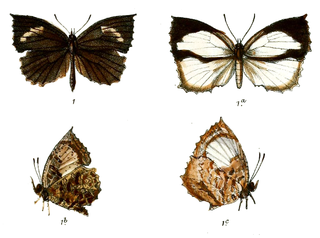
Allotinus drumila, the crenulate darkie, is a small butterfly found in India, Burma, Thailand, Laos, Vietnam, and Yunnan (China) that belongs to the lycaenids or blues family.

Tarucus theophrastus, the common tiger blue, pointed Pierrot or African Pierrot, is a small butterfly found in the Old World tropics. It belongs to the lycaenids or blues family.
Meigenielloides is a genus of flies in the family Tachinidae.
Microaporia is a genus of flies in the family Tachinidae.
Ophirion is a genus of parasitic flies in the family Tachinidae.

Trigonospila is a small genus of parasitic flies in the family Tachinidae.

Gymnosoma clavatum is a species of tachinid flies in the genus Gymnosoma of the family Tachinidae.
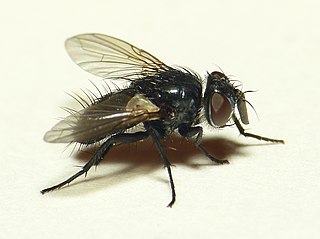
Blondeliini is a tribe of parasitic flies in the family Tachinidae. Larvae are parasitoids of other insects, mostly beetles and caterpillars. Although nearly cosmopolitan, its greatest diversity is in the New World and especially in South America.

Trigonospila brevifacies is a species of true fly in the family Tachinidae native to eastern Australia. This species is also found in New Zealand. Like the vast majority of tachinid flies, T. brevifacies is a parasitoid of other insects, specifically late larval stages of a number of species of Lepidoptera. It is also known as the Australian Leaf-Roller Fly or Leafroller Fly.
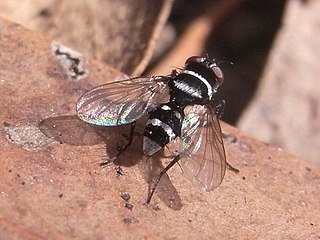
Trigonospila cingulata is a species of fly in the family Tachinidae.

Oxycera morrisii, the white-barred soldier, is a European species of soldier fly.
Dipteran morphology differs in some significant ways from the broader morphology of insects. The Diptera is a very large and diverse order of mostly small to medium-sized insects. They have prominent compound eyes on a mobile head, and one pair of functional, membraneous wings, which are attached to a complex mesothorax. The second pair of wings, on the metathorax, are reduced to halteres. The order's fundamental peculiarity is its remarkable specialization in terms of wing shape and the morpho-anatomical adaptation of the thorax – features which lend particular agility to its flying forms. The filiform, stylate or aristate antennae correlate with the Nematocera, Brachycera and Cyclorrhapha taxa respectively. It displays substantial morphological uniformity in lower taxa, especially at the level of genus or species. The configuration of integumental bristles is of fundamental importance in their taxonomy, as is wing venation. It displays a complete metamorphosis, or holometabolous development. The larvae are legless, and have head capsules with mandibulate mouthparts in the Nematocera. The larvae of "higher flies" (Brachycera) are however headless and wormlike, and display only three instars. Pupae are obtect in the Nematocera, or coarcate in Brachycera.

Goniglossum wiedermanni is a species of tephritid or fruit flies in the family Tephritidae, and the only species in the genus Goniglossum.

Nemoraea pellucida is a species of fly in the family Tachinidae.

Paragus pecchiolii is a species of hoverfly.
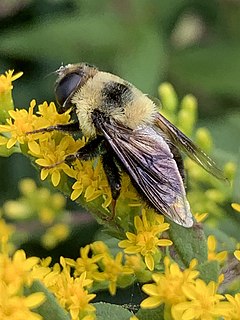
Eristalis flavipes, the orange-legged drone fly, is a species of hoverfly native to North America. It flies from early April to mid-October, and occur in a wide variety of habitats, particularly wetlands. E. flavipes measures 11-16 mm in length.
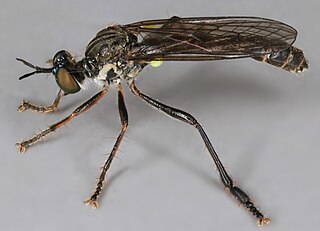
Dioctria hyalipennis is a Holarctic species of robber fly in the family Asilidae.

Meromacrus gloriosus, the Glorious Elegant, is a species of syrphid fly in the family Syrphidae. Originally described from Mexico by Frank Hull in 1941 this black and yellow wasp mimic has since been observed in many locations in Texas and New Mexico.
Sericomyia carolinensis, is a rare species in the family Syrphidae, found in the Southeastern part of the United States. It is distinguished by its all yellow face, single pair of small narrow yellow spots, and yellow pilose scutellum. Adults noted feeding on pear blossoms. The larval stage is unknown but is likely a "rat tailed" type larvae inhabiting nutrient rich waters, typical for the genus Sericomyia.














